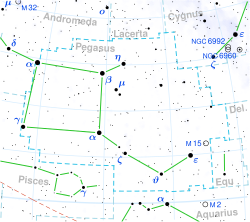51 Pegasi
| Observation data Epoch J2000.0 Equinox J2000.0 |
|
|---|---|
| Constellation | Pegasus |
| Right ascension | 22h 57m 27.98004s |
| Declination | +20° 46′ 07.7912″ |
| Apparent magnitude (V) | 5.49 |
| Characteristics | |
| Spectral type | G5V |
| Apparent magnitude (B) | 6.16 |
| Apparent magnitude (R) | 5.0 |
| Apparent magnitude (I) | 4.7 |
| Apparent magnitude (J) | 4.66 |
| Apparent magnitude (H) | 4.23 |
| Apparent magnitude (K) | 3.91 |
| U−B color index | +0.20 |
| B−V color index | +0.67 |
| V−R color index | 0.37 |
| R−I color index | 0.32 |
| Astrometry | |
| Radial velocity (Rv) | −33.7 km/s |
| Proper motion (μ) |
RA: 207.25 ± 0.31 mas/yr Dec.: 60.34 ± 0.30 mas/yr |
| Parallax (π) | 64.07 ± 0.38mas |
| Distance | 50.9 ± 0.3 ly (15.61 ± 0.09 pc) |
| Absolute magnitude (MV) | 4.51 |
| Details | |
| Mass | 1.11 M☉ |
| Radius | 1.237 ± 0.047 R☉ |
| Luminosity | 1.30 L☉ |
| Surface gravity (log g) | 4.33 cgs |
| Temperature | 5571 ± 102 K |
| Metallicity [Fe/H] | 0.20 dex |
| Rotation | 21.9 ± 0.4 days |
| Age | 6.1–8.1 Gyr |
| Other designations | |
| Database references | |
| SIMBAD | data |
| Exoplanet Archive | data |
| ARICNS | data |
| Extrasolar Planets Encyclopaedia |
data |
51 Pegasi (abbreviated 51 Peg), also named Helvetios, is a Sun-like star located 50.9 light-years (15.6 parsecs) from Earth in the constellation of Pegasus. It was the first main-sequence star found to have an exoplanet (designated 51 Pegasi b, unofficially dubbed Bellerophon, later named Dimidium) orbiting it.
The star is of apparent magnitude 5.49, and so is visible with the naked eye under suitable viewing conditions.
51 Pegasi has a stellar classification of G5V, indicating that it is a main-sequence star that is generating energy through the thermonuclear fusion of hydrogen at its core. The effective temperature of the chromosphere is about 5571 K, giving 51 Pegasi the characteristic yellow hue of a G-type star. It is estimated to be 6.1–8.1 billion years old, somewhat older than the Sun, with a radius 24% larger and 11% more massive. The star has a higher proportion of elements other than hydrogen/helium compared to the Sun; a quantity astronomers term a star's metallicity. Stars with higher metallicity such as this are more likely to host planets. In 1996 astronomers Baliunas, Sokoloff, and Soon measured a rotational period of 37 days for 51 Pegasi.
Although the star was suspected of being variable during a 1981 study, subsequent observation showed there was almost no chromospheric activity between 1977 and 1989. Further examination between 1994 and 2007 showed a similar low or flat level of activity. This, along with its relatively low X-ray emission, suggests that the star may be in a Maunder minimum period during which a star produces a reduced number of star spots.
...
Wikipedia

